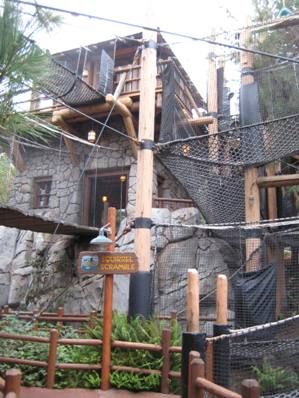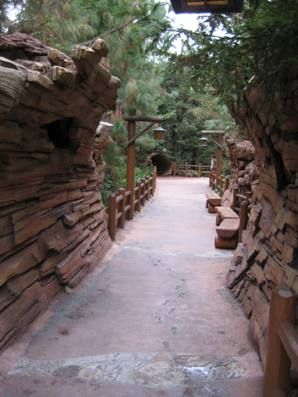Perhaps the best thing about buying the passes is that we can spend lots of time on the playgrounds.
One of the earliest attractions in Disneyland, opened in 1956, Tom Sawyer Island is reached by a short raft trip across the 'Rivers of America.' Originally themed around the adventures of Tom Sawyer, Becky Thatcher, and Huck Finn, it was re-imagineered after the success of the Pirates of the Caribbean movies as Pirates' Lair on Tom Sawyer Island. In either incarnation, the island is a giant playground, one built with the imagination - and budget - of the Walt Disney Corporation. A central ridge is honeycombed with narrow, twisting caves, just wide enough for two kids to pass and just narrow enough for crouching parents to need to find an alcove to let one another scoot by. One cave, Dead Man's Grotto, features the beating heart of Davy Jones in its iron chest, an Audio-Animatronic pirate shackled to a wall with a tale of woe to tell, and a surprise visit by Pintel and Ragetti should a guest try to disturb the pirates' treasure. Other caves feature chests of treasure or locked doors with narrow grates to peek through, and at one end of the ridge the partial remains of a wrecked galleon is haunted by ghostly chains. Atop the ridge, reached through the caves in the interior, is a lookout with telescopes.
Around the island there is a suspension bridge leading to Tom and Becky's treehouse, which the kids can climb and explore, and a pontoon bridge made of barrels for crossing a small cove. Turning a capstan winch pulls a chest of treasure, with a pirate skeleton dangling beneath, from the water, and working a pair of pumps empties out a sunken boat and reveals more treasure, and another pair of skeletons, within. At the far end of the island is Fort Wilderness - the fort was once an actual attraction in which guests could climb the stairs and look out on the island from its log towers, but now it's just a façade - and a huge pile of pirate treasure to climb on.
California Adventure, the theme park built atop the old parking lot of Disneyland, features a playground of its own, Redwood Creek Challenge Trail, in the Grizzly Peak 'land.' RCCT, located directly across from the Grizzly River Run flume ride, takes its inspiration not from fiction but from the real Sierra Nevada. Its winding pathways are filled with animal tracks, and lead guests through the stump of a giant sequoia and forested groves. Fallen trunks of the big trees take the place of caves in RCCT, and the suspension and pontoon bridges are replaced by thick rope cargo nets stretched between a smokejumpers' training tower and a combination ranger station and forest fire lookout, complete with a working Osborne Fire Finder.
There's a rock wall with a pair of traverses - climbing the rocks of Tom Sawyer Island is actually prohibited, as I was informed by a polite white-hatted Disneyland security guard years ago - and a twisting slide set in a jumble of boulders - a 'rock slide,' of course. Two more slides are set inside giant logs. There's a tiny stream which can be crossed by hopping on rocks made of playground rubber-mulch or a short bridge which is subject to sudden inundation. Carved statues of figures from California aborigine stories line a segment of trail, and a small cave allows a guest to learn which animal spirit they most resemble. The one attraction sure to have a line on every visit is the combination tire swing and zip line in the smokejumpers' tower.

Tom Sawyer Island and Redwood Creek Challenge Trail are two of my favorite attractions at the Disneyland Resort - in fact, if I had to make a list, they would certainly be in the top four, and depending on my mood when I made the list, they might even be in the top two spots. The Disney theme parks are perhaps best known for their rides, for the way they create an amazing sensory environment and tell a story, whether it's the recounting of a famous tale or something wholly original. But what I love about the island and the trail is that while the same attention to detail is provided in creating the environment, the story - the adventure - is left to the guests to create.
I'll bet you already know where I'm going with this.
Gamers use the term sandbox to describe 'open worlds' in which characters are free to explore. One of the problems with 'sandbox' as a term of art, in my experience, is that it can leave the impression of a featureless plain - lone and level sands stretching far away. This impression is sometimes invoked by gamers who dislike such game-worlds and the associated playstyle, for one reason or another.
But most 'sandbox' game-worlds are more like playgrounds than true sandboxes, and in my experience, the best examples of these game-worlds rise to the level of playgrounds-by-Disney. These playgrounds are not random collections of furnishings. Rather, they are filled with places and people and institutions of interest, which are meant to attract the players and their characters to interact with them without determining when or how those interactions may unfold. They have themes or motifs which add depth - there are patterns to recognize and apply.
On various forums over the years, one of the recurring critiques of sandbox game-worlds offered is that some players, when confronted with too much freedom of choice, have a deer-in-the-headlights moment; in fact, I've come across it enough times that about a month ago, I started a thread at Big Purple asking gamers to help me understand what induces 'sandbox paralysis.' The answers from those posters who actually experience this were enlightening - those who took the thread as a chance to bash sanbox play, far less so.
For awhile now I held the ideas that putting genre-tropes front and center and offering a familiar setting may help with making sandbox - playground - play more readily accessible to gamers who might otherwise be turned off by the prospect. Tom Sawyer Island and Redwood Creek do both in their 'call to adventure.' Reading the responses to the 'sandbox paralysis' thread, I think that addresses some gamers' issues with the playstyle, but by no means all; some players are truly only happy if they feel they can reliably expect certain experiences from playing the game, experiences which require the referee's active participation in developing, experiences which a sandbox game-world is, in their estimation, unlikely to provide.
And that's okay, of course. Playgrounds aren't for everyone. I feel the same way about more linear, more story-oriented gaming; while I understand its appeal, it's not for me. Horses for courses.
But I do think it would helpful for gamers discussing sandbox game-worlds and playstyle to remember that they are much more than boxes of sand for digging holes and making castles. They are playgrounds as well, and in the really clever ones, the jungle gyms and slides and ladders are disguised as a pirate's lair or a Sierra Nevada forest.


I too would count Tom Sawyer Island as a favorite when visiting Disneyland.
ReplyDeleteWhen it comes to sandbox game-worlds, my mind always falls back on how I saw things as a kid. That patch of grass was a dark forest for my action figures. That moss and rain puddle, a murky swamp. Turning my bicycle upside down created a deadly machine that my action figures had to navigate safely. Empty paper towel rolls were dark tunnels and so forth. With the right kind of eyes, there are countless things to explore right in front of you.
You're right, it's not just a box of sand, but I would argue that it's not disguised as a pirate's lair. It is a pirate's liar. Some people just forgot and only see it as a jungle gym with slides and ladders.
"Turning my bicycle upside down created a deadly machine that my action figures had to navigate safely."
DeleteHa, that brings back memories! A friend's GI Joe lost an arm to his bike spokes.
Playground is probably a better metaphor than sandbox. For me, "choose your path" player freedom has always been the distinguishing characteristic of RPGs.
ReplyDeleteFor me as well.
DeleteShame about the fort no longer letting you play in it. I loved Tom Sawyer Island when I was a kid. I miss all the old attractions. Still can't wait to take my kids when they are old enough.
ReplyDeleteWe have zoo passes for the same reasons you mentioned. San Diego Zoo is huge and we can do 2-3 hour visits and just come back another day. Even better, we live about 15 miles away.
We're eleven miles from the Disney Resort - it's roughly twenty minutes on surface streets.
Delete